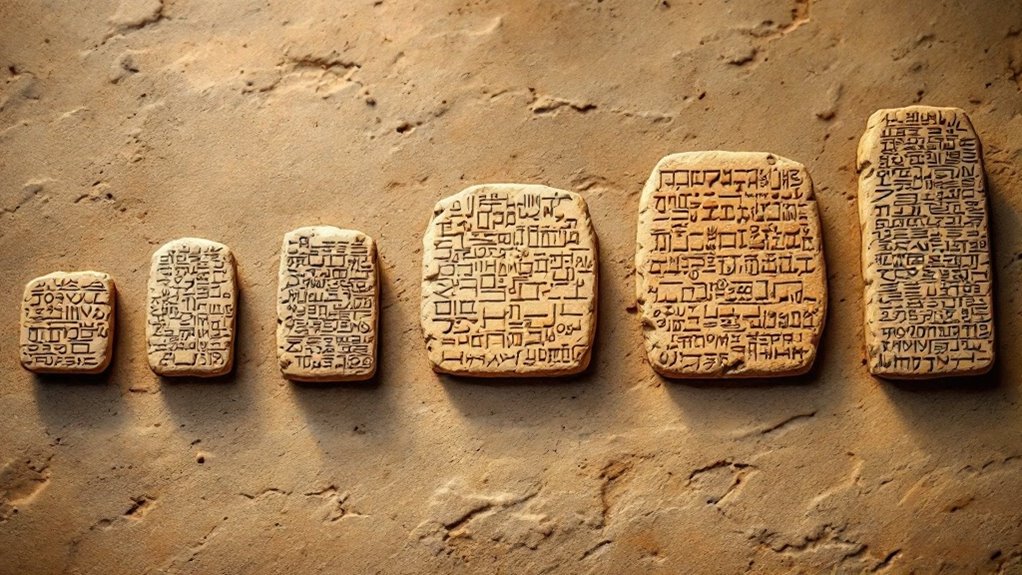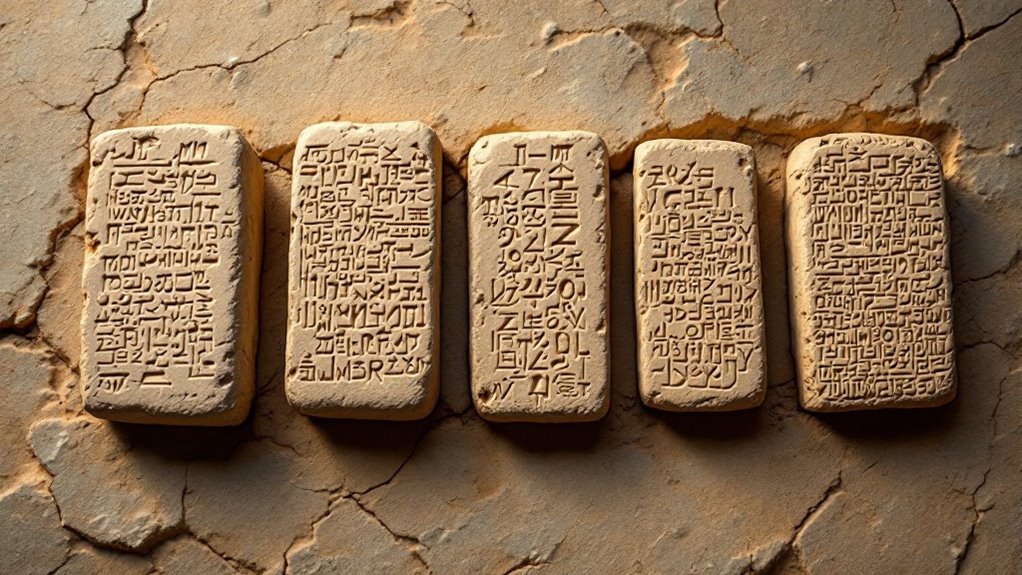The emergence of writing systems in ancient Mesopotamia marks a significant milestone in human history.
Sumerian cuneiform originated as a basic counting system using tokens, gradually evolving into a complex form of written communication. This evolution took the script from its earliest beginnings to the development of syllabic writing, a process characterized by innovation and adaptation.
As we examine the history of Sumerian cuneiform, it becomes clear that this ancient script played a pivotal role in shaping the written word as we know it today. The journey of Sumerian cuneiform is a story of human ingenuity and the pursuit of knowledge, leaving an indelible mark on the course of history.
By examining the development and impact of this script, we can gain a deeper understanding of how it laid the groundwork for modern writing systems.
Origins and Early Development
Imagine a world emerging from prehistory, where civilization is taking its first steps in the ancient Near East. In Mesopotamia’s fertile lands, the Sumerians developed an innovation that would leave a lasting legacy – cuneiform writing. Around 3500-3200 BCE, scribes in the city-state of Uruk began inscribing symbols onto clay tablets with wedge-shaped tools. Initially, these symbols represented basic goods and economic transactions, a practical solution for a growing civilization.
As time passed, cuneiform evolved from pictographs to a more sophisticated system based on sounds. The symbols transformed into wedge-shaped cuneiform signs, allowing for more complex expressions. This change reflected the growing complexity of Sumerian society, enabling the writing system to convey a wide range of thoughts and experiences.
With this newfound power of written expression, the Sumerians laid the foundation for literary, religious, and scholarly traditions that would shape the course of history. Cuneiform, once used for simple accounting, became a vessel for preserving and passing down the wisdom and stories of an ancient civilization. The written word had become a powerful tool, allowing the Sumerians to record their knowledge, beliefs, and cultural practices for generations to come.
Transition to Pictographic Signs
As Sumerian society grew more complex, their writing system evolved to keep pace. The token system, which dated back to 8000 BCE, gradually gave way to pictographic signs. These early symbols, drawn on clay tablets or inscribed in stone, directly represented objects, names, and concepts, forming a logographic writing system. Sumerians created their earliest pictographs using a sharpened reed stylus, arranging symbols in vertical columns. Over time, the switch to a blunt stylus led to the development of wedge-shaped symbols, characteristic of cuneiform writing. This change enabled the creation of a wide range of glyphs and symbols, allowing for the recording of abstract ideas and personal names. As the script evolved and expanded, it became the standard for Sumerian literature, legal documents, and commemorative stelae. The original logographic system incorporated phonetic signs, reducing the number of symbols needed and paving the way for cuneiform’s widespread adoption across Mesopotamian cultures.
Phonetics and Syllabic Writing

The development of phonetics in Sumerian cuneiform was a significant turning point in the history of writing. This script evolved from a basic system of symbols representing words to a more complex system where symbols represented sounds. As a result, writers could record abstract ideas and personal names with greater ease. The script became better equipped to capture the nuances of spoken language, allowing people to write about any topic they chose.
However, this development also created challenges. Sumerian logograms were polyphonic, meaning a single symbol could represent multiple sounds. This led to confusion and ambiguity in the writing system. To address this issue, writers began using determinative signs to provide context and clarify the meaning of symbols.
The emergence of a syllabic structure, where each consonant-vowel pair had its own unique symbol, made the script a powerful tool for preserving and sharing knowledge. Despite its complexity, with symbols having multiple possible readings, the script remained a vital part of Sumerian communication.
The achievement of developing phonetics and syllabic writing in Sumerian cuneiform is notable. It marked a major milestone in the history of human communication and had a lasting impact on the development of written language. The ability to represent sounds and ideas in writing enabled people to express themselves in new and innovative ways, paving the way for significant advances in literature, science, and other fields.
Spread and Adaptation to Other Languages
The Sumerian writing system quickly spread across the ancient Middle East, gaining traction with various civilizations. By the mid-third millennium BCE, the Akkadians had adopted cuneiform, blending it with their own Semitic language to create a unique writing system. This mixed system combined Sumerograms with phonetic writing, allowing the Akkadians to pay homage to the Sumerian script while forging their own path. Scribes would choose between Sumerograms and phonetic complements depending on the context and dialect they were using. As cuneiform spread beyond Mesopotamia, it was adapted by speakers of Elamite, Eblaite, Hittite, Hurrian, Luwian, and Urartian, each leaving their mark on the script’s evolution. The Old Persian alphabet was also influenced by cuneiform, a testament to its lasting impact. From the 3rd to the 1st millennium BCE, cuneiform played a significant role in shaping the written word across the ancient Middle East, with its influence extending far and wide.
Decline, Decipherment, and Legacy
As we watch cuneiform’s gradual decline, we see newer, simpler writing systems emerge and gradually erode its dominance. Over time, the once-vibrant script becomes a relic of the past, mainly used in ceremonial and religious contexts. The Phoenician alphabet and its derivatives gain popularity, their simplicity and flexibility making them preferred by scribes and scholars.
| Aspect | Decline | Legacy |
|---|---|---|
| Usage | Diminishing | Revived through decipherment |
| Influence | Eroded by new systems | Provides insight into ancient civilizations |
| Study | Neglected for centuries | Intensive research and ongoing discoveries |
The work of Henry Rawlinson and Georg Friedrich Grotefend, who deciphered Old Persian and revealed the secrets of cuneiform, paved the way for renewed interest in ancient languages and cultures. Their breakthrough, confirmed in 1857, sparked a new wave of research into long-forgotten languages and cultures.
Cuneiform’s legacy offers valuable insights into ancient trade, economies, literature, and social structures. The script’s evolution over time provides linguists with a rich source of data, allowing them to analyze language development and interactions between language families.
Researchers continue to study cuneiform, and each new inscription unearthed and each refined translation brings us closer to understanding ancient Mesopotamian culture and its lasting impact on human civilization. This ongoing research helps us better understand our shared heritage and the significant role cuneiform played in shaping human history.
Frequently Asked Questions
What Materials Were Used to Create Cuneiform Tablets Besides Clay?
We Sumerians used a range of materials to record our thoughts and stories, including bone, metal, and stone. Our writing tools carved out paths of knowledge on these surfaces, allowing us to preserve our history and legends for future generations. By using these different materials, we were able to create a lasting record of our culture and experiences, one that would endure long after the clay tablets had crumbled.
How Did the Development of Cuneiform Influence Sumerian Art and Architecture?
The development of cuneiform had a profound impact on Sumerian art and architecture. As we recorded our stories, laws, and prayers on clay, stone, and metal, every cuneiform stroke influenced the aesthetic of our structures. This writing system inspired the construction of grand temples that seemed to touch the heavens and ziggurats that connected the earthly and divine realms. The cuneiform characters themselves conveyed power, religion, and commerce, transforming our world through the written word. The advent of cuneiform allowed Sumerians to express complex ideas and beliefs, which in turn shaped the visual and structural elements of their art and architecture. The resulting structures, adorned with intricate cuneiform inscriptions, stood as testaments to the civilization’s rich cultural heritage and its ability to convey meaning through both written word and physical space.
Were There Any Notable Sumerian Authors or Poets Who Wrote in Cuneiform?
Among the Sumerian scribes, Enheduanna stands out for her remarkable contributions. As the world’s first known author, she wrote temple odes that still resonate with us today, praising the moon god Nanna in hymns that have endured for centuries. Enheduanna’s work showcases her mastery of metaphor, weaving existing poems into new narratives that continue to captivate readers. Her writing, preserved in cuneiform, has left an lasting impact on literature. Enheduanna’s position as a high priestess likely influenced her work, imbuing her writing with a deep understanding of Sumerian culture and religion. Her legacy serves as a testament to the power of literature to transcend time and connect with people across cultures.
Did the Invention of Cuneiform Change Sumerian Education Practices?
The invention of cuneiform had a profound impact on Sumerian education. With the advent of this early writing system, a new class of professionals emerged – scribes who were skilled in the art of writing. As a result, schools were established to train these scribes in the intricate craft of cuneiform, a process that took many years to master. The curriculum was built around this demanding skill, marking a significant shift in educational practices. This change led to a more formalized system of education, where students would spend years learning the complexities of cuneiform under the guidance of experienced instructors. The development of cuneiform writing played a crucial role in shaping the course of Sumerian education, paving the way for a more sophisticated and specialized approach to learning.
How Has the Decipherment of Cuneiform Impacted Modern Linguistic Research?
Deciphering cuneiform has opened up a new window into ancient languages, allowing us to uncover the secrets of long-lost cultures. By cracking the code of this ancient writing system, we’ve gained a deeper understanding of how civilizations told stories and passed down myths. This, in turn, has given us valuable insights into the human psyche and how it has evolved over time. The decipherment of cuneiform has essentially given us the freedom to explore and compare the languages and stories of ancient cultures, shedding new light on the complexities of human history. As we continue to study and learn from cuneiform, we’re able to piece together a more complete picture of humanity’s past, and that’s a truly significant discovery.


